|
Snowflake Touring -- Northern Ontario |
|
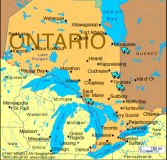 As a resident of Southern California, I have to go travel to photograph
snowflakes. Over the years this has turned into a long-term winter
adventure of mine, and I've found most definitely that different
locations serve up different kinds of snow crystals.
As a resident of Southern California, I have to go travel to photograph
snowflakes. Over the years this has turned into a long-term winter
adventure of mine, and I've found most definitely that different
locations serve up different kinds of snow crystals.
Northern Ontario is an excellent region for snowflake hunting, and I've
taken many trips there and got thousands of pictures. The climate in the northeast
parts of the province is especially ideal for producing excellent
stellar snow crystals -- it's good and cold, it snows frequently, and
usually there is little or no wind. |
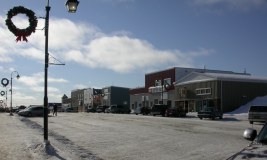 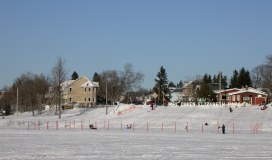 The town of Cochrane (see arrow in the map above) is one of my
favorite spots, and I've visited many times to photograph snowflakes.
The population is around 5000, and it's quite a friendly place.
The first picture on the left shows the view across (frozen) Lake
Commando, at a favorite sliding hill in the middle of town. The second picture shows the
main business section of town.
The town of Cochrane (see arrow in the map above) is one of my
favorite spots, and I've visited many times to photograph snowflakes.
The population is around 5000, and it's quite a friendly place.
The first picture on the left shows the view across (frozen) Lake
Commando, at a favorite sliding hill in the middle of town. The second picture shows the
main business section of town.
You might think from the map that this should be called central
Ontario, not northern Ontario. But in fact the region around
Cochrane and Hearst is about as far north as you can drive in the
province. Air Canada takes you as far as Timmins (see
map), which is a substantially larger town than Cochrane. |
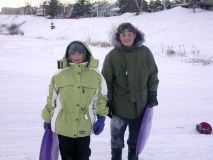 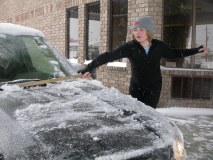 My kids don't see much snow, so a trip to the frozen north is quite an
experience. Even scraping the ice off the car can be fun!
My kids don't see much snow, so a trip to the frozen north is quite an
experience. Even scraping the ice off the car can be fun! |
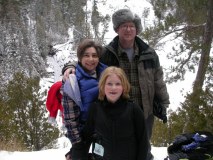 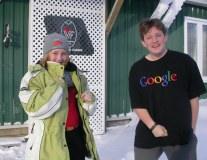 Being from a warm climate, my kids haven't quite
figured out the basic principles of cold weather -- like the concept
that a t-shirt might not be quite enough to keep you warm.
Being from a warm climate, my kids haven't quite
figured out the basic principles of cold weather -- like the concept
that a t-shirt might not be quite enough to keep you warm. |
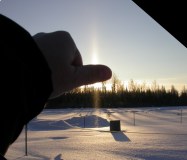 One morning I got up to greet the rising sun (which is not too hard in
northern Ontario, since sunrise in January might be around 9am) and
witnessed an excellent light pillar, shown at left. My thumb is
blocking the sun, and the vertical streaks above and below are caused by
ice crystals in the air. Even though the sky was clear, tiny ice
crystals were growing and falling -- an example of snow without clouds.
One morning I got up to greet the rising sun (which is not too hard in
northern Ontario, since sunrise in January might be around 9am) and
witnessed an excellent light pillar, shown at left. My thumb is
blocking the sun, and the vertical streaks above and below are caused by
ice crystals in the air. Even though the sky was clear, tiny ice
crystals were growing and falling -- an example of snow without clouds.
These small, plate-like crystals tend to orient themselves as they
fall, so their broad faces are nearly parallel to the ground. The facets
partially reflect the sunlight, each individual crystal acting like a
tiny mirror. You have to think about it for a minute, but when the
air is filled with countless tiny, nearly horizontal reflectors, you
will see vertical streaks like those in the picture. Note that the streak
below my thumb comes from fairly nearby crystals, so the streak lies in
front of the darker backgrounds. If you look carefully, you can
see sparkles from individual ice crystals in the lower streak.
Ice crystals cause all sorts of interesting optical phenomena, and
you can read more at
Ice Crystal Halos. |
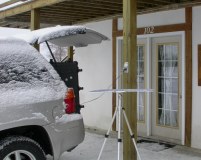 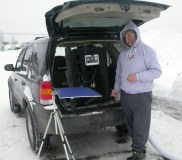 The first picture at left shows one of my better locations for snowflake
photography. My car is on the south side of the building, which
nicely blocks the north winds. The overhead deck provides more
shelter, and there is a convenient outlet nearby. The second
picture gives a better view of my snowflake camera inside my rented SUV.
The first picture at left shows one of my better locations for snowflake
photography. My car is on the south side of the building, which
nicely blocks the north winds. The overhead deck provides more
shelter, and there is a convenient outlet nearby. The second
picture gives a better view of my snowflake camera inside my rented SUV. |
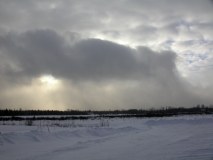
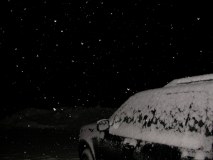 The best snow for snow crystal photography comes from low clouds that
practically hug the ground, as in the first picture at left. If
the crystals form too high, then they tend to sublimate before they
reach the ground. Crystals forming near the ground have sharper
facets.
The best snow for snow crystal photography comes from low clouds that
practically hug the ground, as in the first picture at left. If
the crystals form too high, then they tend to sublimate before they
reach the ground. Crystals forming near the ground have sharper
facets.
Large snowflakes (second picture) appear when the snowfall is
heavy. Lighter snowfalls tend to bring better crystals. |
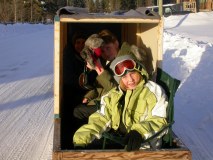 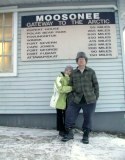 On one of my family trips to Ontario we caught a train, called the Polar
Bear Express, from Cochrane to Moosonee (see the map above).
The town of Moose Factory is right across James Bay, and travel between
towns is mostly via snowmobile. The picture at the far right shows
the back end of a snowmobile "taxi".
On one of my family trips to Ontario we caught a train, called the Polar
Bear Express, from Cochrane to Moosonee (see the map above).
The town of Moose Factory is right across James Bay, and travel between
towns is mostly via snowmobile. The picture at the far right shows
the back end of a snowmobile "taxi".
The snow crystals weren't so great in Moosonee, at least in my
limited experience. I've found that the best crystals are not
often found near large bodies of salt water. The water just keeps
the air temperatures too high, even as far north as James Bay. |
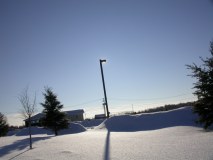 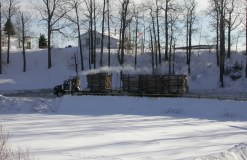 The air can be amazingly clear in the frozen north. It's almost
hard to believe that the sun is behind the lamp post in the first
picture at right (which you can tell from the shadows).
The air can be amazingly clear in the frozen north. It's almost
hard to believe that the sun is behind the lamp post in the first
picture at right (which you can tell from the shadows).
Logging trucks are a common sight in northern Ontario. If you
ever think the world is running out of trees, go for a ride on the Polar
Bear Express. The boreal forests go on for hundreds of miles in
all directions, with barely any signs of civilization. |
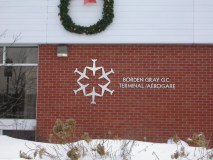 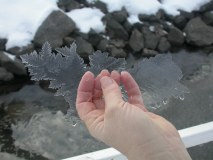 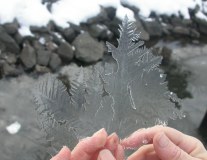 |
|
The first picture above, taken at the Sault Ste.
Marie airport, demonstrates just how much the Canadians like their snow
crystals.
The next two pictures show ice crystals my wife lifted from the
shore of Lake Superior during our stay in Sault Ste. Marie. Note
the dendritic structure and how the branches form at 60-degree angles.
These crystals grew from liquid water (at the surface of the lake),
but show some features that are similar to snow crystals.
|
